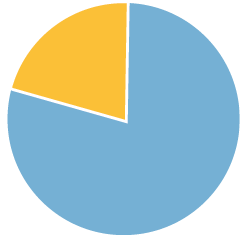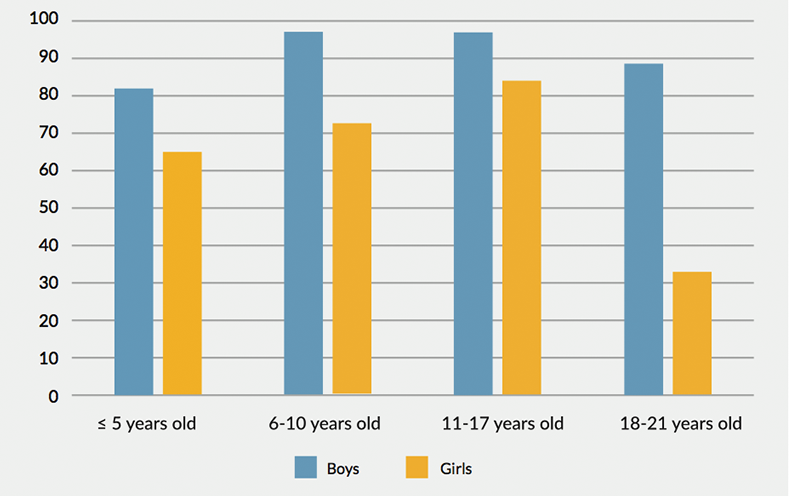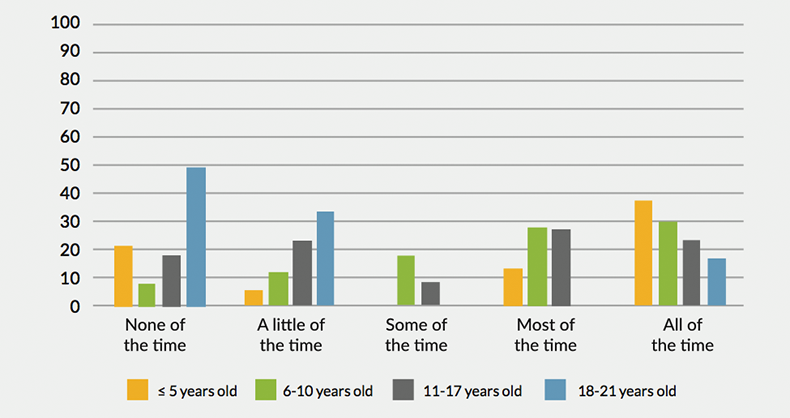Research Summary
School Settings of Students with Fragile X
Date Published: December 2018
What was the research about?
School support services can help children with fragile X syndrome (FXS) meet their learning needs. By law, students who need special education have written plans that state their needs and goals. These are called individualized education plans (IEPs) or individualized family service plans (IFSPs), depending on the child’s age. We wanted to know more about the types of educational settings and different types of support students with FXS get and how this support affects learning. Knowing this can help parents and teachers support children to reach their full potential.
What did the research team do?
In this study, we looked at school settings and support for students with FXS. We surveyed parents and caregivers of children with FXS. We asked if their child had an IEP or IFSP, how much time their child spent in a general education classroom, and what extra support the child had. We asked parents to rate how their child performs in school and about their child’s goals and progress. We also asked how well their child does with everyday life skills, such as following a schedule.
We used this information to look at:
- how educational settings and supports change as a child gets older,
- if boys and girls differ in types of settings and supports,
- if children who have other conditions, like autism, get different supports,
- if supports are tied to academic performance, and
- how satisfied parents are with their child’s goals and school services.
Who was in the study?
A total of 982 parents and caregivers took the survey. Participants were mostly mothers, college-educated, and married. Their children were mostly boys, non-Hispanic, white, and ranged in age from preschool aged to 21 years old.
982 parents and caregivers took the survey
Figure 1a. Child’s Sex

21% Female
Figure 1b. Child’s Age
What did the research team learn?
Teacher knowledge of FXS diagnosis and special education supports differed between boys and girls.
Most students with FXS attended public school and got special education services. Almost all teachers of boys, but only half the teachers of girls, knew about their FXS diagnosis. More boys than girls had an IEP or ISFP. Even fewer girls had an IEP or ISFP as they got older.
Figure 2. Percent of FXS Students with IEP or IFSP

| Boys | Girls | |
|---|---|---|
| ≤ 5 years old | 95.7% | 86.3% |
| 6-10 years old | 98% | 82% |
| 11-17 years old | 98.8% | 76.7% |
| 18-21 years old | 97.5% | 50% |
Figure 3. Percent of Students Getting Extra Support

| Boys | Girls | |
|---|---|---|
| ≤ 5 years old | 82% | 66.5% |
| 6-10 years old | 97.2% | 72.7% |
| 11-17 years old | 97.3% | 85% |
| 18-21 years old | 88.6% | 33.3% |
Most students got extra support in the classroom.
We found that most students who spent some time in a general education classroom had at least one type of special support to help meet their unique need. The most common form of support was a classroom aide. Other types of support included: changes in the classroom layout, help with transitions, curriculum changes, changes to the schedule, behavior support, or peer tutors.
Most students ages 17 and under got at least one kind of support. Older students were more likely to have extra support. However, most girls ages 18-21 were getting the least amount of support. In general, boys tended to receive more extra support than girls.
Time spent in a general education classroom varied based on age and other factors.
Most students spent at least some time in a general education, or inclusive, classroom. But, how much time depended on their age, other conditions, and everyday life skills.
Younger students, both boys and girls, spent more time in a general education classroom than older students.
Figure 4a. Percent of Time Spent in General Education Classroom among Boys with FXS

| ≤ 5 years old | 6-10 years old | 11-17 years old | 18-21 years old | |
|---|---|---|---|---|
| None of the time | 23.5% | 25.3% | 40.6% | 50% |
| A little of the time | 13.6% | 32.1% | 37.5% | 40% |
| Some of the time | 13% | 20.9% | 18.7% | 8.6% |
| Most of the time | 14.2% | 14.1% | .8% | 1.4% |
| All of the time | 14.2% | 4.8% | 2.4% | 0% |
Figure 4b. Percent of Time Spent in General Education Classroom among Girls with FXS

| ≤ 5 years old | 6-10 years old | 11-17 years old | 18-21 years old | |
|---|---|---|---|---|
| None of the time | 21.6% | 8% | 17.8% | 50% |
| A little of the time | 5.9% | 12% | 23.3% | 33.3% |
| Some of the time | 0% | 18% | 8.2% | 0% |
| Most of the time | 13.7% | 28% | 27.4% | 0% |
| All of the time | 37.3% | 30% | 23.3% | 16.7% |
Children with other conditions or behavior issues spent less time in general education classrooms.
Boys with FXS who had autism, aggression, or self-harming behavior were less likely to spend any time in a general education classroom than boys who did not have these behaviors. Girls with FXS who had self-harming behavior or who had more than one other condition were less likely to spend any time in a general education classroom than girls who did not have these conditions.
Boys with more everyday life skills spent more time in a general education classroom.
Boys who spent more time in a general education classroom at a younger age were more likely to be able to perform everyday life skills later on, without help, than boys who had spent less time in a general education classroom. Some of these skills included writing their name and reading a restroom sign.
![]()
Parents ratings of school performance were different for boys and girls.
Across all age groups, parents of boys reported their son’s performance in reading, writing, and math was substantially below grade level. Parents of older boys were more likely to report their sons were substantially below grade level than parents of younger boys. In contrast, less than half of the parents of girls reported their performance was substantially below grade level for writing and reading. However, more parents of girls reported poorer performance in math.
Parents were happy with their child’s school goals.
Most parents felt that they were involved the right amount in making decisions about their child’s goals and services. They also felt that their child’s goals were challenging and appropriate and that their child had made a lot or some progress towards their goals.
What does this mean for families?
Families of children with FXS can support their child by working with their school to meet their child’s needs.
This can help ensure children get the supports they need. supports they need as early as possible. By getting special education services early on, children with FXS may have better school performance. With appropriate supports, children with FXS may be able to spend more time in a general education classroom which may improve their everyday life skills. This, in turn, can help them to become more independent as they get older.
Related resources
Visit the National Fragile X Foundation (NFXF) to get more resources on Education and Fragile X Syndrome. Some of these resources include:
- Helpful tips and goals for establishing a school program for a child with fragile x syndrome(PDF).
- A list of guidelines for supporting your child’s education through the years (PDF).
Learn what you can do to support your child by going to Genetics Education Materials for School Success website and reviewing their guide to Education Supports for children with FXS.
Take a look at the Center for Parent Information and Resource Center’s Developing your Child’s IEP to learn how to work effectively with schools. Check out their resource library for family-friendly materials on early intervention, school-aged children, and high school & beyond.
Read the full article by Dr. Raspa and colleagues
Source. Nash, R., Riley, C., Gilbertson, K., Paramsothy, P., Raspa, M., Wheeler, A. C., Dziuban, E. J., & Peacock, G. (2019). A description of the educational setting among individuals with fragile X syndrome. Am J Intellect Dev Disabil. 114 (1), 57-76.